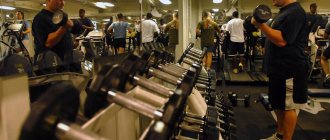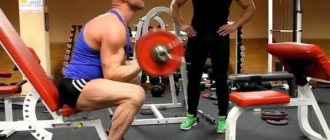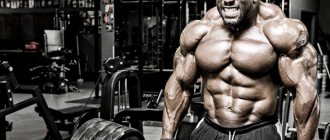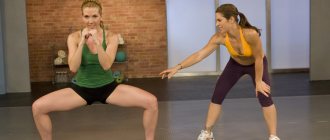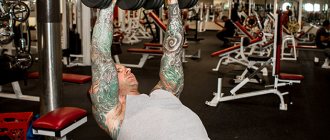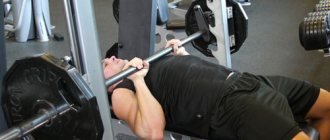Many spectators of championships and competitions in rhythmic gymnastics look in fascination at flexible and plastic female athletes who really know how to control their bodies and even use various complementary equipment during performances: balls, ribbons, and so on.
But few people know that such mastery was preceded by many years of hard training. Even one rhythmic gymnastics workout requires complete dedication, diligence and coordination. From childhood, gymnasts are accustomed to the fact that they must be strong, to the point that they do not perceive many minor injuries as such.
What is rhythmic gymnastics
Rhythmic gymnastics is a sport that combines excellent physical training, aesthetics of movement and a slight hint of choreography. Unlike artistic gymnastics, rhythmic gymnastics involves a more dance-like performance of elements, including the use of additional equipment:
- gymnastic ball;
- gymnastic ribbon;
- jump ropes;
- mace
Training gymnasts in rhythmic gymnastics includes not only the study of gymnastic and acrobatic elements, good stretching, but also the development of plasticity and coordination of movements. Practice shows that rigor and strong discipline are important in this sport.
No time for sweets and boys: how gymnasts train
Elena Vasilyeva, Sputnik.
If a young gymnast does poorly, without the proper desire, she is intimidated by dancing and modeling. In the children's and youth school of rhythmic gymnastics they say that acrobatics, dancing, aesthetics are for failed gymnasts, real talents will pull their toes and bend their backs to the last. Sputnik correspondents found out what lies behind the beautiful posture of young gymnasts.
Butterscotch is no longer hidden from the coach
Children can start gymnastics from the age of four, and at six some of them go to their first competitions. And even such kids have four-hour training sessions at least four times a week, let alone older gymnasts: all the time that is not devoted to school is spent on gymnastics. Already at nine in the morning in the hall they were pulling socks and honing the program with subjects of groups of different ages.
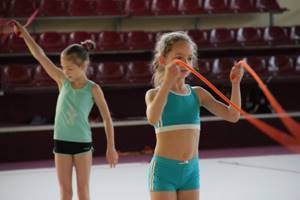
© Sputnik Sergey Pushkin
Gymnasts with skipping rope
The idea that a gymnast cannot afford an extra bun did not immediately come true - coach Alexandra Dakimovich assured that morals in sports now are not as strict as they once were. She says that during her training years she had to hide toffees in her backpack to deceive the coach.
“Of course, there is no need to overindulge in fatty and floury foods, but basically little gymnasts eat what they want - they are bad eaters. These children themselves, by their physique, are not at all voracious. It’s a different matter for the older ones, they already want a lot, like a sweet snack and to meet with the boys, but they don’t have time,” the group coach told a Sputnik correspondent.
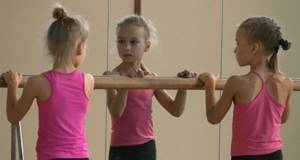
© Sputnik Elena Vasilyeva, Sergey Pushkin
Four-hour training and splits: how young gymnasts train
Here they said that children are often brought to classes by parents - the latter dream of a stellar future. But those who walk without desire cannot be detained, even if the children are talented.
Medal and make up
“When stretching begins, we move from play to loads, many quit. It’s very difficult to withstand it without the desire,” the coach assured.
As a result, at the stage when the desire for everyday life overshadows the thirst for a ribbon and a swimsuit, almost half of the children drop out. Ten percent reach the stage when it’s time to talk about gymnastics as a serious sport.
“We try to find an approach to the majority, but there are those who cannot be lured by anything - gentle children who love themselves. And it happens that parents have enough of playing and take away their talented, beautiful child,” the coach said about the reasons for leaving the sport.
By the way, it is not necessary to send your child to classes at an early age; it all depends on how developed he is, including intellectually.
“Some people are already smart at five years old, while others don’t understand anything. There are two five-year-old children standing, and one does everything, and the other does not understand how to stretch her leg. But, of course, it’s easier for those who came earlier to do stretching,” said the school’s choreographer Alla Vladimirovna.
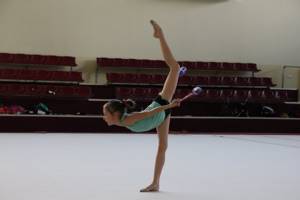
© Sputnik Sergey Pushkin
Little gymnast training
It is customary here to talk to children like adults, especially without ceremony. True, the coaches claim that the children are much better developed than their peers. The level of intellectual development is taken into account during enrollment, along with innate physical data.
“Long beautiful legs, a pretty face - it’s all important. But I start asking questions with a simple “What’s your name?” It is important how the child reacts. And only then we look to see if the lift is high and the knees are level,” lists coach Alexandra.
Here she demonstrates to one of the school students what a real gymnast should look like - the splits, the lift and the so-called fold.
When asked why you need gymnastics, little Danuta answers categorically, “I want a medal,” and a gold one at that. In addition to the medal, the children want a swimsuit and a ribbon. The coach said that this is one of the main incentives. When children are capricious, the older group is invited to join them, they perform in beautiful swimsuits - and the capriciousness stops.
“I’ll be patient, I want a swimsuit,” the coach laughs. In addition to the leotard, the gymnasts want to wear makeup and a ribbon. The latter is a favorite subject not only of the majority of spectators, but also of the children themselves, although they like to play with it rather than study. Some parents buy items - a hoop, a ball, a ribbon, clubs - at their own expense; the school provides the most gifted ones.
You have to pay about a million rubles for a ribbon, the same for clubs, and a little less for a jump rope and a ball. However, many parents are ready to give any money.
“I immediately realized that I would become a coach, and I have been working for 16 years now - even as a child, groups of juniors were left to me. I still pay attention on the street if a girl with beautiful legs walks by. They tell me – stop it already – but I can’t miss my legs, which are designed for training,” said the school coach.
Rhythmic gymnastics training with children
Most people start doing gymnastics in childhood, when the muscles are even more elastic, and the child’s weight allows him to support himself while doing strength exercises. Gradually, the child develops his athletic abilities, and new exercises and elements are much easier for him.
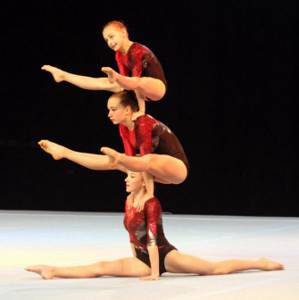
Basic principles of training:
- Warm-up is mandatory. This is a necessary element of any training related to physical activity, from gymnastic training to choreographic classes. Warming up prepares the body for more intense exercise.
- The child must have all the necessary equipment for classes, and clothes must be comfortable. This is important so that the child can perform the exercises efficiently and safely for himself and others, and also to train discipline. Forgetting your rhythmic gymnastics uniform, gymnastics mat, or shoes at home is unacceptable.
- The coach must monitor each child in the group, especially if we are talking about preschoolers. For this reason, groups should not be overcrowded - this is a serious violation. Insufficient attention from the trainer can lead to the child easily breaking the technique of performing an element and getting injured, or accidentally or deliberately preventing another from performing an element, which will lead either to a conflict or, again, to injury.
- Safety comes first. All equipment must be in good working order. The coach’s task is to check the balance beam, horizontal bars, wall bars and other sports equipment used during classes for breakdowns and damage.
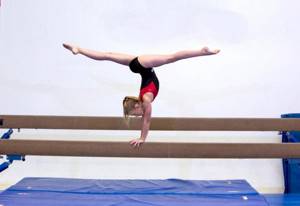
Gymnast training
Gymnasts' training is systematic work, focused on winning, and working with complex exercises. To achieve these goals, certain exercises and methodological techniques are used. They are selected in accordance with the general and physical preparation of the athlete. Its capabilities of the body, as well as motor and mental abilities.
The training process must be systematic and consistent. Several training cycles are developed at once: for a week, for a month, for a year, for two years and for four. They describe the complexity of the exercises, their volumes and stages at which the best results should be achieved. The most important thing is that the athlete does not lose interest in training due to great physical and psychological stress. To improve your psycho-emotional background, as well as maintain the body, we recommend the drug Apitonus P - this is a complex of natural vitamins that was created for athletes. You will always be in a great mood and in decent physical shape.
Training loads depend on many factors: age, initial training. The foundations of sports training were formed through the joint work of teacher-trainers, scientists, as well as experience in educational work. These principles are based on the principles of training and education. By following them, the gymnast carries out both one training session and a multi-year process of training at all levels of sports qualifications.
Workout structure
The structure of individual rhythmic gymnastics training is no different from group training. It includes:
- Warm up. Warm-up is necessary to warm up the muscles. This will help avoid injury and make learning and performing exercises more effective.
- The main part of the training. Working out the elements, stretching. The coach determines what needs to be learned right now, and thus he plans rhythmic gymnastics training. Stretching is one of the most important elements, but during personal training it can be overlooked if it is not necessary.
- Exit. Relaxation of muscles to avoid soreness.
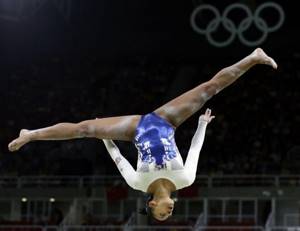
Some more tips for parents:
* If you want to send a girl to do rhythmic gymnastics, look for a coach who will not break the child’s psyche and develop an inferiority complex in her charges.
* Support young gymnasts, help them not to lose faith in themselves, do not allow coaches to insult children (unfortunately, many of them are guilty of this). Trust your daughters, and if they constantly complain about the coach, think about switching to another specialist. Yelling and abuse can seriously ruin a child's life.
* Do not expect that the girl will necessarily have a wonderful figure; if this is not genetically inherent, then gymnastics will not help. You can develop good posture and the ability to move beautifully, but you cannot change what is inherent in nature.
* Teach girls to lose with dignity, not to consider losing the end of the world, and to respect their rivals.
* Be prepared to work hard yourself, gymnastics will enter the life of the family and begin to dictate its terms, and you will have to adapt.
* Closely monitor the health of your children and, at the slightest warning sign, consult a doctor to prevent the development of serious consequences.
Nevertheless, despite the difficulties, many parents of young gymnasts are pleased that they chose this particular sport for their daughters, and unanimously say: it is better to try and leave if “it doesn’t work” than not to try and then regret it.
Why should a coach be a specialist?
Beautiful smooth movements, precise execution of acrobatic and gymnastic elements, skill with a ball or ribbon are the constituent elements of rhythmic gymnastics. The danger of getting injured is also rhythmic gymnastics. Children, whose training requires absolute attention from the coach, cannot always determine the line when pain during stretching is normal, and when it is a hint of improper execution of the exercise.
The coach’s task is not only to teach children gymnastics, but also to prevent injuries by properly warming up and teaching their students the correct technique for performing the elements. In addition, if a muscle strain does occur, or the child simply bumps and bruises, the coach should be able to provide first aid if necessary, as well as advise on further actions.

A non-professional will not cope with all these tasks. Moreover, if a self-taught gymnast, or even a non-gymnast at all, undertakes gymnastics, this is primarily a risk to the child’s health.
Sports nutrition for gymnasts
When doing gymnastics, you spend a lot of energy and time; to restore your body and improve your health, it will be useful for you to take sports nutrition for gymnasts. We recommend the dietary supplement Leveton P. A drug that is created specifically for athletes preparing for competitions. It is most effective for gymnasts. Leveton P contains a full complex of vitamins, microelements and amino acids that are necessary for any athlete. We also recommend taking Elton P , which increases energy and strength.
Exercises with a scarf
To exercise with a scarf, get a piece of silk, very light material, 2 m long and 80-90 cm wide. A gas scarf is suitable for this purpose. With it you can do many of the movements described in the exercises with the tape, such as arcs and circles in the front (Fig. 24 above) and lateral (Fig. 25) planes. The scarf should be held with one hand by the narrow edge.
Swing the scarf, holding it by the wide edge.
Run quickly with the scarf raised above your head (Fig. 26 above)
Make jumps, holding the scarf with both hands by the wide (Fig. 27) or narrow (Fig. 28) edges.
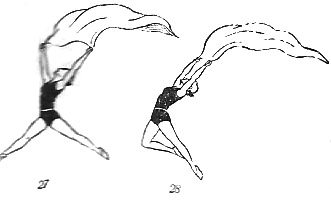
Lean back (Fig. 29)
Stand on one leg, maintaining balance. (Fig. 30)
Note: Individual movements with a scarf can also be combined into short exercises, performing them to music.
Positive and negative aspects
Looking at the movements of the gymnasts, few spectators think about how much time, effort, patience, will and endurance were invested in this performance. Hours of training, bringing every movement to automatism, fatigue, pain - the child will have to face all this. What do parents need to be prepared for if they decide to connect their child’s fate with rhythmic gymnastics?
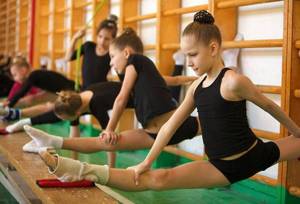
pros
In addition to the negative aspects, gymnastics undoubtedly has benefits both for the physical development of a preschooler and for his mental health, forming character and will.
What does regular training develop in a child?
- Posture, flexibility, gait. Rhythmic gymnastics classes help in the formation of correct posture, develop flexibility, and also form a beautiful, easy gait.
- Plasticity and sense of rhythm. Thanks to the close connection between gymnastics exercises and musical accompaniment, girls develop an excellent sense of rhythm, they move perfectly and can dance to any tune.
- Self confidence. Sport is always about self-confidence and self-confidence, which is reflected in all aspects of life.
- Developing fortitude, character, perseverance and desire for success. Training helps young athletes become disciplined and purposeful individuals. Such children, as a rule, do not react overly emotionally even to a stressful situation, but are able to show prudence and strength of character.
- Good mood. Sport becomes one of the best antidepressants due to the production of endorphins.
- New friends and acquaintances will certainly appear when visiting the sports section.


